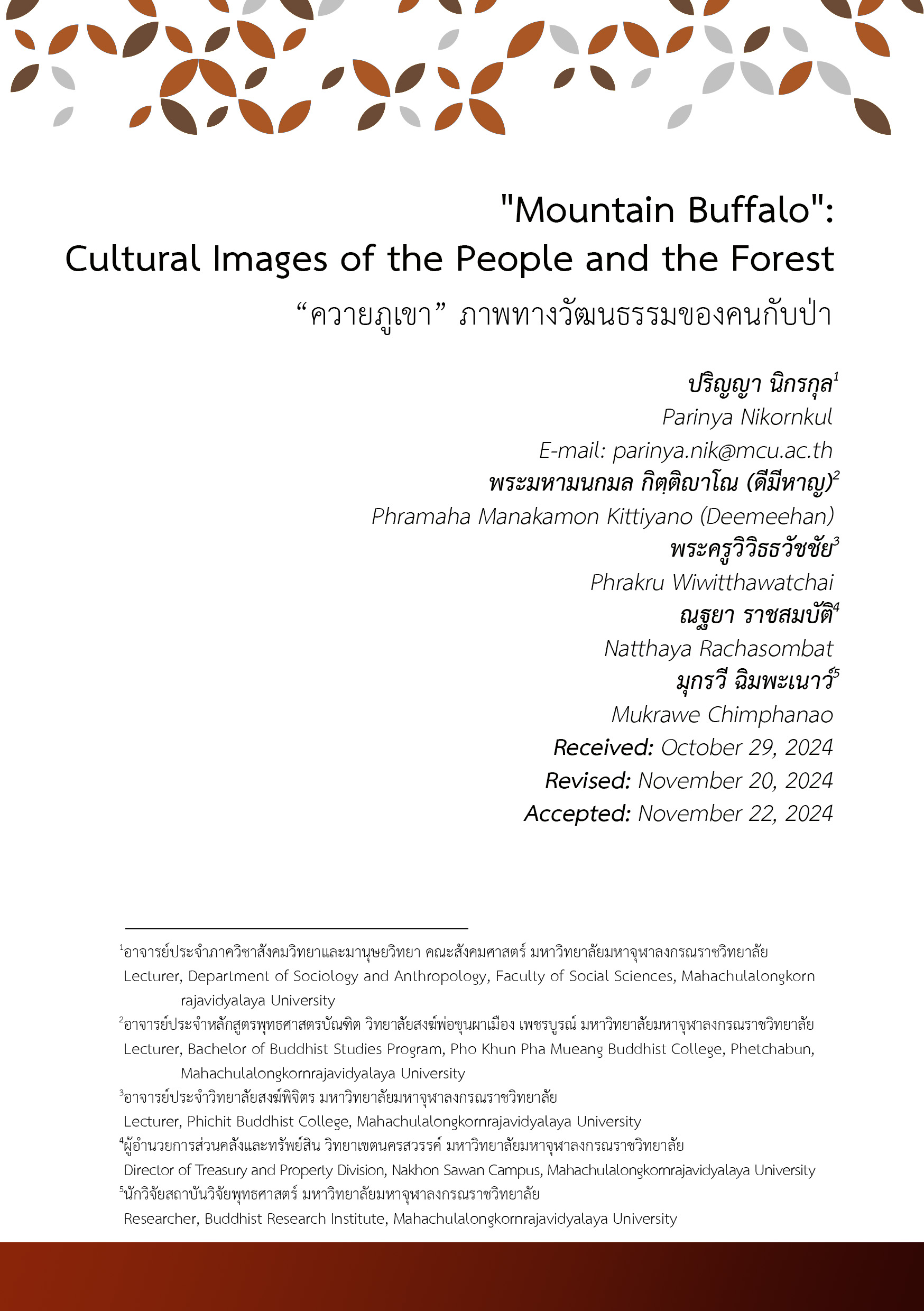“ควายภูเขา” ภาพทางวัฒนธรรมของคนกับป่า “ควายภูเขา” ภาพทางวัฒนธรรมของคนกับป่า
Main Article Content
บทคัดย่อ
บทความนี้มีวัตถุประสงค์เพื่อศึกษานิเวศวัฒนธรรมของมนุษย์และธรรมชาติในพื้นที่ป่าตะวันตกของประเทศไทย โดยใช้การวิเคราะห์ภาพถ่ายการเลี้ยงควายภูเขาของชาวกะเหรี่ยงบ้านวุ้งกะสัง หมู่ที่ 10 ตำบลโป่งน้ำร้อน อำเภอคลองลาน จังหวัดกำแพงเพชร ผ่านกรอบแนวคิดของโรล็องด์ บาร์ตส์ ในเรื่อง “ความหมายที่สาม” “โวหารของภาพ” และแนวคิดของปิแอร์ บูร์ดิเยอ เกี่ยวกับทุนทางวัฒนธรรม และฮาบิทัส โดยการผสมผสานระหว่าง หน่วยวิเคราะห์ภาพ และ หน่วยวิเคราะห์เชิงสังคมวัฒนธรรม เพื่อให้ครอบคลุมทั้งในมิติของภาพถ่าย (สัญลักษณ์และความหมาย) และบริบททางสังคมของการเลี้ยงควายภูเขาของชาวกะเหรี่ยงเป็นวัฒนธรรมที่สืบทอดมายาวนาน ซึ่งควายภูเขาไม่เพียงเป็นสัตว์เลี้ยง แต่ยังเป็นสัญลักษณ์ที่สะท้อนถึงความสัมพันธ์เชิงลึกระหว่างคนกับธรรมชาติ โดยมีบทบาทสำคัญในระบบนิเวศวัฒนธรรม การดำรงอยู่ของควายภูเขาและวิถีชีวิตของชุมชนต้องพึ่งพิงทรัพยากรธรรมชาติอย่างคลองสวนหมากและห้วยน้ำขาว ซึ่งเป็นแหล่งน้ำสำคัญที่ช่วยรักษาความสมดุลระหว่างมนุษย์ สัตว์ และสิ่งแวดล้อมในพื้นที่นี้ การเลี้ยงควายภูเขาไม่ได้เป็นเพียงกิจกรรมทางเศรษฐกิจ แต่ยังมีความหมายเชิงสัญลักษณ์ที่ซับซ้อน สอดคล้องกับแนวคิด “ความหมายที่สาม และโวหารของภาพ” ของบาร์ตส์ ซึ่งสะท้อนถึงมิติทางวัฒนธรรมและความสัมพันธ์เชิงลึกที่ไม่สามารถอธิบายได้ผ่านการบรรยายโดยตรง ความสัมพันธ์ระหว่างชุมชนกับควายภูเขาแสดงถึงกระบวนการทางวัฒนธรรมที่แฝงความหมายทางสังคมซึ่งฝังอยู่ในวิถีชีวิตของชาวกะเหรี่ยง ในแง่ของทฤษฎีของบูร์ดิเยอ “ทุนทางวัฒนธรรม” ของชุมชนกะเหรี่ยงสะท้อนผ่านการเลี้ยงควายภูเขาในฐานะมรดกที่สืบทอดจากบรรพบุรุษ ซึ่งเป็น ฮาบิทัส ที่ฝังรากลึกในวิถีชีวิตและการปฏิบัติทางสังคมของชุมชน การเลี้ยงควายเป็นเครื่องมือที่เชื่อมโยงคนกับธรรมชาติ และเป็นตัวอย่างของทุนทางวัฒนธรรมที่ถูกผลิตและสร้างขึ้นใหม่ผ่านกระบวนการทางสังคมและประเพณีที่มีความสำคัญต่อชุมชน นอกจากนี้ การเลี้ยงควายยังเป็นปัจจัยสำคัญในการควบคุมการเจริญเติบโตของป่า โดยทำให้พื้นที่ป่ามีความโปร่ง เปิดโอกาสให้เกิดการเติบโตของพืชพันธุ์ต่าง ๆ เช่น ผักและเห็ดที่สามารถหาได้ตามฤดูกาล ซึ่งส่งเสริมเศรษฐกิจชุมชนและสร้างรายได้ โดยทั้งหมดนี้สะท้อนถึงความซับซ้อนทางวัฒนธรรมและการอยู่ร่วมกันระหว่างมนุษย์และธรรมชาติที่ลึกซึ้ง
Downloads
Article Details

This work is licensed under a Creative Commons Attribution-NonCommercial-NoDerivatives 4.0 International License.
References
Barthes, R, & Suwiranon, P. (1995). Rhetoric of the Image. Thammasat University Journal 21 (2), 110-131.
Belsey, C. (2006). Poststructuralism: A Very Short Introduction. Bangkok: The Princess Maha Chakri Sirindhorn Anthropology Centre (public organization).
Boonwanno, T. (2022). The Relationships among the Core Concepts of Pierre Bourdieu. Journal of Liberal Arts, Ubon Ratchathani University, 18(1), 1-33.
Borivethanan, T. (2023). Ban Wung Kasang. Community Ways. Bangkok: The Princess Maha Chakri Sirindhorn Anthropology Centre (public organization).
Bourdieu, P. (1979). La distinction. Critique sociale du jugement. Paris: Les Editions de Minuit.
Chaiya, K. (2019). Roland Barthes’s Fundamental Concept of Semiology. Journal of Humanities and Social Sciences , 7(2), 27-61.
Charoensin-o-larn, C. (2012). Semiology, structuralism, poststructuralism and the study of political science. (2nd ed). Bangkok: Wiphasa.
Designated Areas for Sustainable Tourism Administration (Public Organization). (2020). Ban Wung Kasang Cultural Tourism Community. Retrieved from February 22, 2024, from https://cbtthailand.dasta.or.th/webapp/community/content/25/
Khamnu, N. (2019). Debates on Significances of Buffalo and Cow: Contestation of Meaning and Social Space in Thai Society. Mekong-Salween Civilization Studies Journal, 10(1), 159-186.
Lekprasert, S et al., (2012). Water buffaloes: A changing of life cycle amidst social changes. Journal of Liberal Arts, Prince of Songkla University, 4(1), 105-117.
Nilathi, S. (2016).Tradition of Buad Kwai Luang : Anthropology Perspective. Humanities and Social Science Journal, Ubon Ratchathani University, 7(2), 1-14.
Pattanopas, T. (2008). Semantics with images. Academic journal. Faculty of Architecture Chulalongkorn University,1, 35-50.
Preechapanya, P. & Jirasuktaveekul, W. (2000). Karen Knowledge about the Sustainability of Forested Watershed and Agroforestry Ecosystems. Journal of Agriculture, 16(3), 281-290.
Rithmun, K., & Tepsing, P. (2023). “Kintang, Lang Tai, Lae Kwai Lae, Ke Saleng”: The Model and Community Potential in Cultural Capital Management of the Island Community, Trang Province. Journal of Legal Entity Management and Local Innovation, 9(8), 1852-1864.
Saeng-arunchalaemsuk, S. (2022). Lifestyles and Functions of Karen Folktales from Ban Pongnamron, Serm-Ngam District, Lampang Province. Mangrai Saan Journal, 10(2), 35-50.
Sirintanathorn, N. (2018). Capital following to the Concept of Pierre Bourdieu with Community Media. The 10th NPRU National Academic Conference Nakhon Pathom Rajabhat University Nakhon Pathom Thailand, Nakhon Pathom.
The Princess Maha Chakri Sirindhorn Anthropology Centre (public organization). (2023). Pierre Bourdieu. Retrieved from February 22, 2024, from https://www.sac.or.th/exhibition/contempanthro/03-pierre-bourdieu.html
Yanyongkasemsuk, R. (2014). Concepts of Class and Capital of Pierre Bourdieu. Burapha Journal of Political Economy, 2(1), 29-44.

